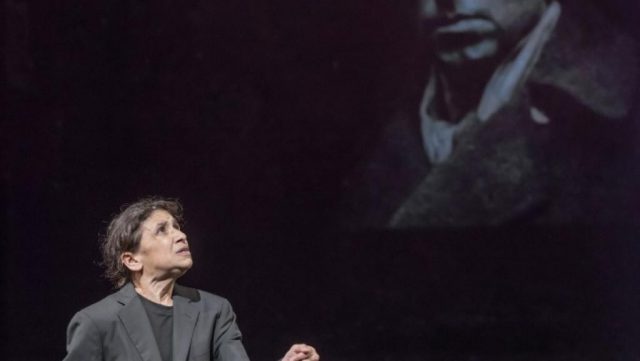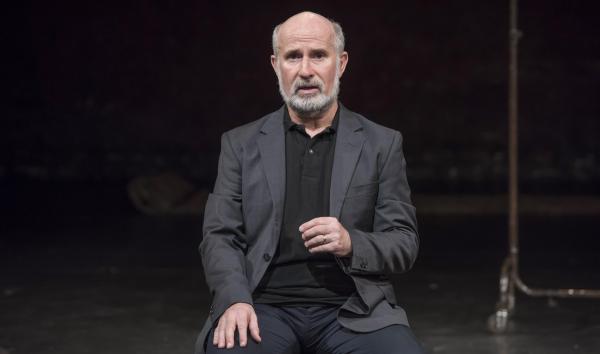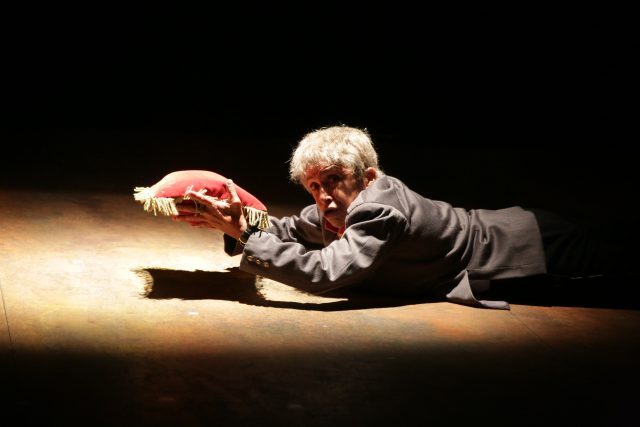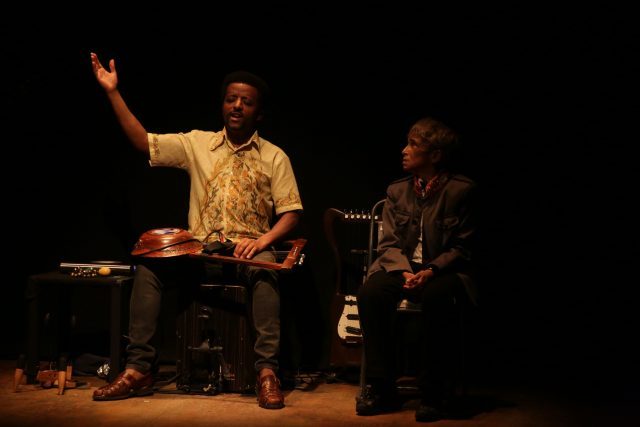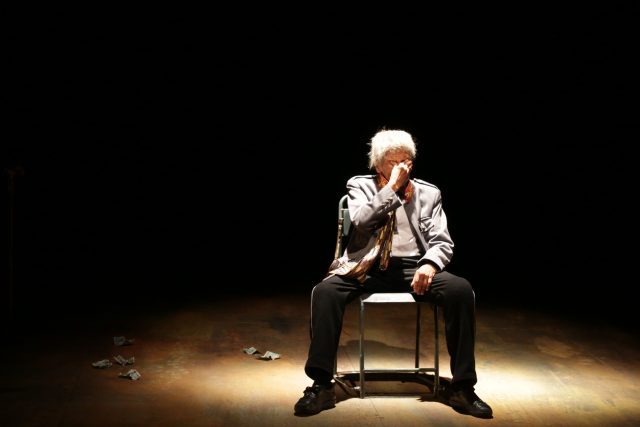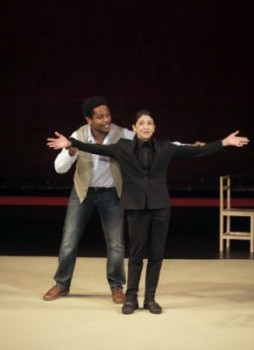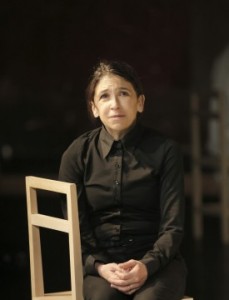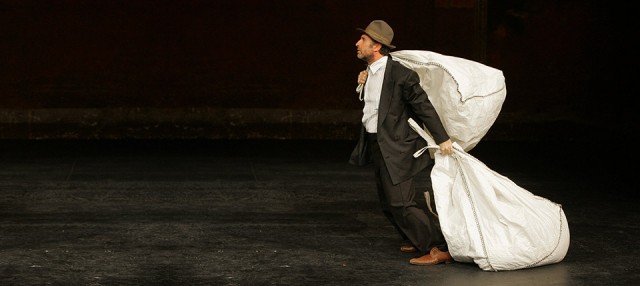
Timon (Kathryn Hunter) throws a feast fit for a queen in Timon of Athens (photo by Henry Grossman)
Theatre for a New Audience, Polonsky Shakespeare Center
262 Ashland Pl. between Lafayette Ave. & Fulton St.
Tuesday – Sunday through February 9, $90-$115
866-811-4111
www.tfana.org
New York-born British actress Kathryn Hunter glitters and glows in William Shakespeare and Thomas Middleton’s Timon of Athens, which opened tonight at Theatre for a New Audience’s Polonsky Shakespeare Center in Fort Greene. Simon Godwin’s production, initiated at the Royal Shakespeare Company and presented here in association with DC’s Shakespeare Theatre Company, should become the gold standard for the rarely performed play, a penetrating and very funny evisceration of greed and true friendship centered around a lust for jewels above all things. The text has been edited by Emily Burns and Godwin to make the lead character female, and TFANA regular Hunter runs with it, delivering an unforgettable, voracious performance as Timon (rhymes with Simon), a widowed noblewoman who loves to host feasts in her mansion where guests bring her trinkets and flatter her to no end and she gives them piles of cash and valuable gems. Painter (Zachary Fine) gives her an absurd portrait, Poet (Yonatan Gebeyehu) heaps words of praise on her, and Jeweller (Julia Ogilvie) offers her a fine stone, and she recompenses them manyfold. Sempronius (Daniel Pearce) insists that Timon not allow one of her servants, Lucilius (Adam Langdon), to marry his daughter despite their being in love, but he changes his mind quickly when she promises him money as a kind of dowry/bribe.
Her loyal steward, Flavius (John Rothman), notifies her that her wealth is dwindling, and the cynical philosopher, Apemantus (Arnie Burton), warns her not to put her faith in these false friends, but she is too caught up in the revelry to pay attention. “I wonder men dare trust themselves with men, / Methinks they should invite them without knives — / Good for their meat and safer for their lives,” Apemantus, the only character not wearing shimmering black or gold but instead a Patti Smith T-shirt, tells the audience. A few moments later, after Timon asks him to be silent, he says, “So. / Thou wilt not hear me now; thou shalt not then. / I’ll lock thy heaven from thee. / O, that men’s ears should be / To counsel deaf, but not to flattery!” When she finally understands that her coffers are empty, she sends out Flaminia, Lucilius, and Flavius to Lucullus (Dave Quay), Sempronius, and Lucia (Shirine Babb), asking for loans, but the trio is cruelly denied. Furious at this drastic change of events, the formerly happy-go-lucky Timon turns her back on the life she so treasured and shared with others. “Nothing I’ll bear from thee / But nakedness, thou detestable town,” she says of Athens. “Take thou that too, with multiplying bans. / Timon will to the woods, where she shall find / Th’unkindest beast more kinder than mankind. / The gods confound — hear me, you good gods all! — / The citizens both within and out that wall, / And grant as Timon grows her hate may grow / To the whole race of mankind, high and low! / Amen.” In the second act, Timon, now in tattered rags, is a bitter woman who spends most of her days digging her own grave until she is discovered by visitors from her past, including Alcibiades (Elia Monte-Brown), who has become the leader of an angry mob protesting the Athenian government.
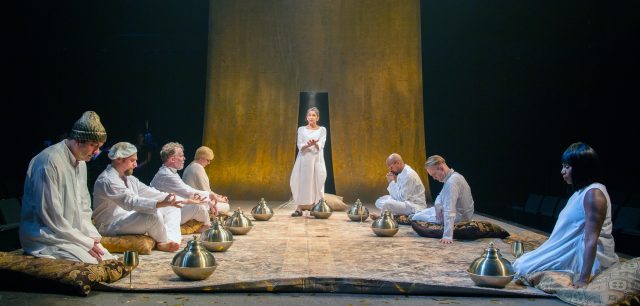
Timon of Athens is regendered in Simon Godwin’s glittering production at TFANA (photo by Henry Grossman)
Godwin’s sublime and timely interpretation of Timon of Athens addresses homelessness, income inequality, the dispossessed, an unsympathetic state, and humankind’s propensity for greed. Timon is a complex character, both antihero and cautionary figure of what can happen if wealth is all that matters and friends are available for purchase. I would say that Hunter is a revelation in the title role, but she’s been a revelation in almost everything I’ve seen her in, from Peter Brook and Marie-Hélène Estienne’s The Valley of Astonishment and Fragments to Hideki Nota’s The Bee and Colin Teevan’s The Emperor. Here she displays a ruggedly coarse physicality that is utterly majestic and downright enthralling, a force of nature unto itself, whether she’s being lifted by her sycophantic, hypocritical guests or carving her own epitaph. The glorious costumes, which range from ostentatious dresses to sleek black suits and, eventually, sackcloth and ashes, are by Soutra Gilmour, who also designed the impressive sets; the stage juts out far into the audience, who sit on three sides, with ramps leading off through two corners.
In the first act, opulence is on view, with a festive table, a large gold backdrop that serves as a doorway, and, later, a rug that apparently needs to be fastened more securely to the floor, as several actors tripped over different parts the night I went. The transformation to a forest for the second act is so dramatic you might want to stay in your seats and watch it instead of hurrying out for the restroom or a drink. At rear left, guitarist and bouzuki player Christopher Biesterfeldt, percussionist Philip Coiro, clarinetist Joshua Johnson, and singer Kristen Misthopoulos perform music by composer Michael Bruce, including one piece based on a Cretan peasant hymn and another from Shakespeare’s fifty-third sonnet. Monte-Brown and Rothman stand out in a strong cast, but it’s Hunter, who has previously portrayed King Lear, Richard III, and Cyrano, who will take your breath away while also making you wonder why you’ve never read or seen this play before.




